#C/2020 F3 (NEOWISE)
Text
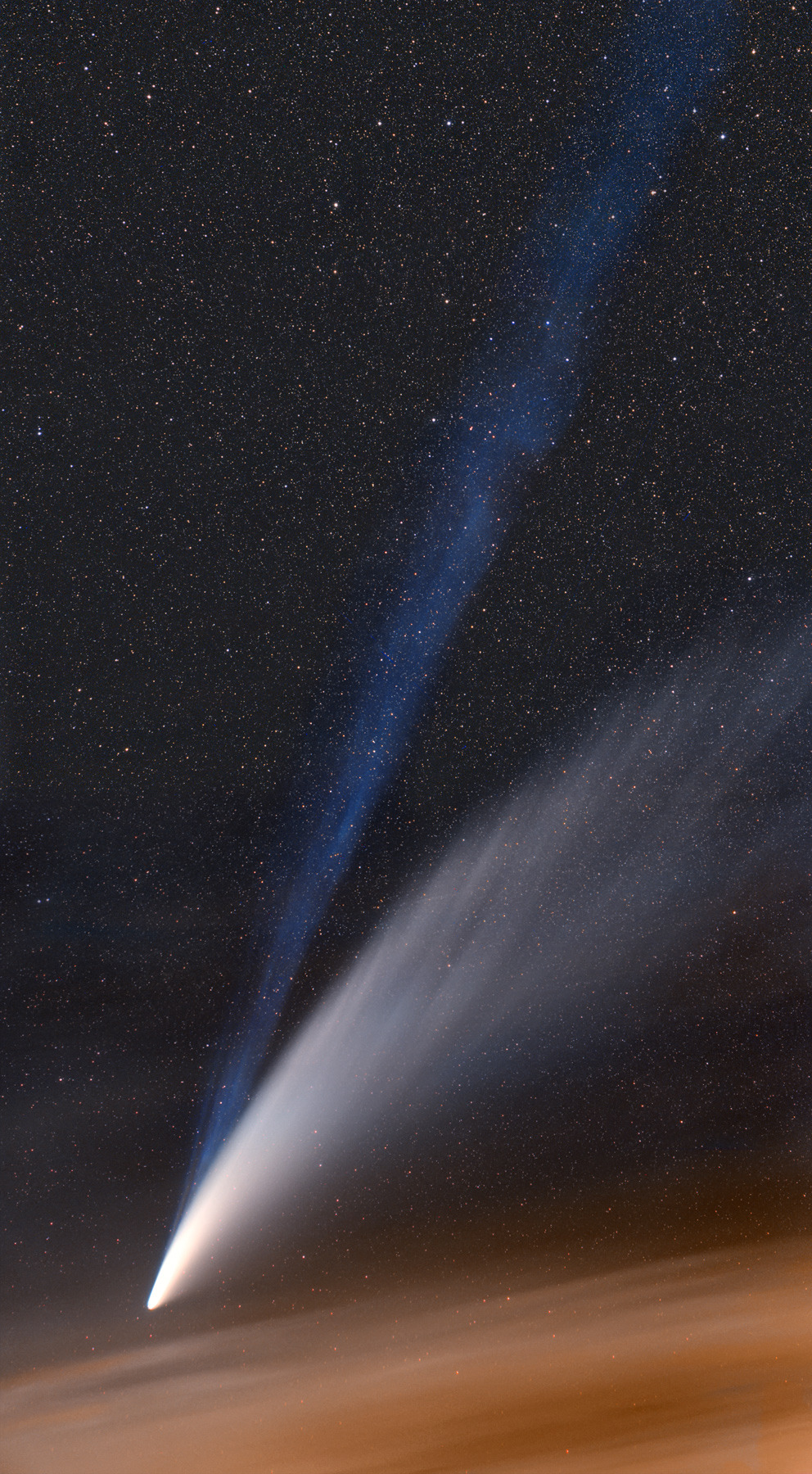
Comet Neowise l Gerald Rhemann
#comet#space#comet neowise#c/2020 f3#astrophotography#astronomy#nasa#solar system#sky#night#stars#galaxy#universe
3K notes
·
View notes
Text

Comet NEOWISE between the Terrils des Jumeaux in Haillicourt, France // Louis Leroux
#astronomy#astrophotography#night sky#solar system#comet#icy body#kuiper belt#comet neowise#C/2020 F3 (NEOWISE)#landscape#beautiful#peaceful#twilight#sunset#france#haillicourt#terrils
165 notes
·
View notes
Text
Comet NEOWISE rising over the Earth just before dawn as seen from the International Space Station. ☄️
—
C/2020 F3 (NEOWISE) or Comet NEOWISE is a long period comet with a near-parabolic orbit discovered on 27 March 2020 by astronomers during the NEOWISE mission of the Wide-field Infrared Survey Explorer (WISE) space telescope.
#Comet NEOWISE#C/2020 F3 (NEOWISE)#NEOWISE#Wide-field Infrared Survey Explorer (WISE)#space telescope#comet#International Space Station#Earth#space#astronomy#astronomers
69 notes
·
View notes
Photo
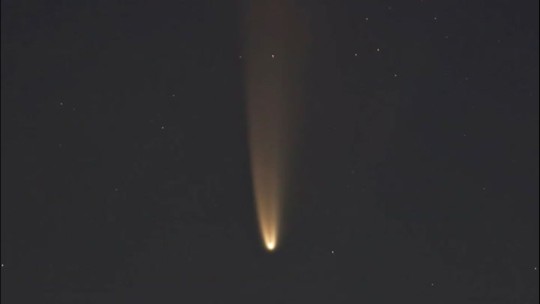
Astronomy #Space #Espace #Astrometry
0 notes
Text
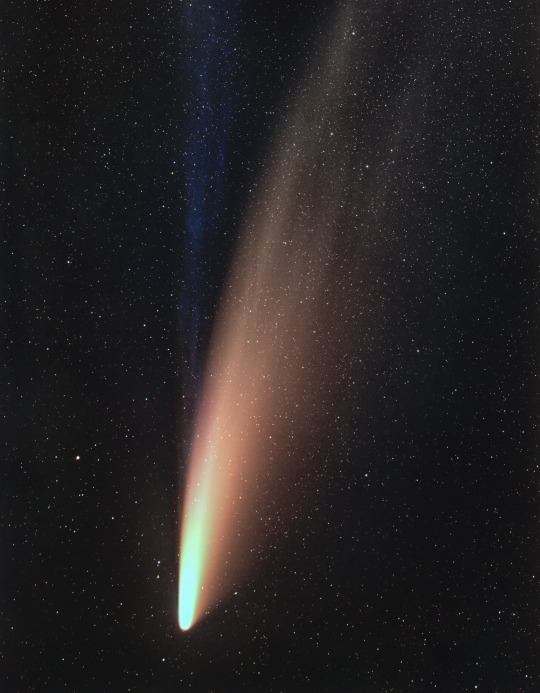
Comet C/2020 F3 NEOWISE
credit
2K notes
·
View notes
Photo
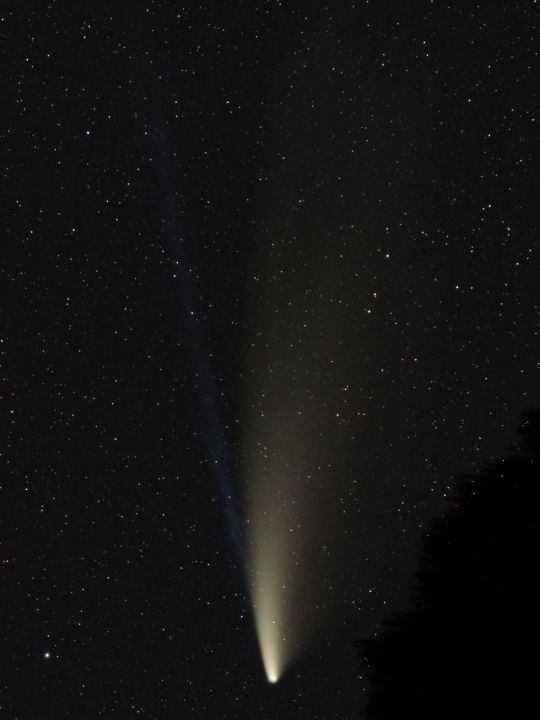
Comet C/2020 F3 (NEOWISE) by By Ron Brecher | July 17th, 2020
100 notes
·
View notes
Video
youtube
2022 July 26
Comet NEOWISE Rising over the Adriatic Sea
Video Credit & Copyright: Paolo Girotti
Explanation: This sight was worth getting out of bed early. Two years ago this month, Comet C/2020 F3 (NEOWISE) rose before dawn to the delight of northern sky enthusiasts awake that early. Up before sunrise on July 8th, the featured photographer was able to capture in dramatic fashion one of the few comets visible to the unaided eye this century, an inner-Solar System intruder that has become known as the Great Comet of 2020. The resulting video detailed Comet NEOWISE from Italy rising over the Adriatic Sea. The time-lapse video combines over 240 images taken over 30 minutes. The comet was seen rising through a foreground of bright and undulating noctilucent clouds, and before a background of distant stars. Comet NEOWISE remained unexpectedly bright until 2020 August, with its ion and dust tails found to emanate from a nucleus spanning about five kilometers across.
∞ Source: apod.nasa.gov/apod/ap220726.html
35 notes
·
View notes
Text

NEOWISEcometix / c/2020f3cometix



[ ( NEOWISE / c/2020 + f3 ) + cometix ~~ NEOWISEcometix / c/2020f3cometix ]
A gender related / connected to the comet c/2020 f3 , also know as NEOWISE . It may be a distant gender , fast , that only appears / let it be seen after long times , shooting through stars , nebulae and planets .
[ flag ID : three rectangular flags with five horizontal stripes , the colours from top to bottom are : dark indigo , bright purple , light pastel yellow , muted lavender , and dark indigo . in the center of the first and second flag there's a white circle with a purple glow and a white trail that fades out at the left side . and in the first flag , on top of the first and last stripe there are many white dots that resemble stars . end ID ]
Coined by the prince 👑

[ PT : Anyone can use the terms that the charming has coined , but ke asks to Please DNI if any of these aply to you: racist, sexist, ageist, antimogai, antiliom, BaB, ableist, transmed, transcum, fujoshi, radfem, terf, proshipper, anti-agere, antifurry, NSFW blogs, (NO)MAP, zoophile, necrophiliac, incestuous or supporter of those who act on these types of paraphilias. end PT ]

#NEOWISEcometix#c/2020f3cometix#cometix#cometix gender#coined by the prince#mogai#liom#mogai blog#liom blog#mogai coining#liom coining#mogai community#liom community#flag coining#term coining#mogai label#liom label#mogai gender#liom gender#mogai term#liom term#mogai safe#liom safe#mogai friendly#liom friendly#actually mogai#category ~ gender
9 notes
·
View notes
Text
Le 10 comete più luminose degli ultimi anni
Le 10 comete più luminose degli ultimi anni
Le 10 comete più luminose in ordine decrescente
C/2020 F3 NEOWISE
mag. 0,9 anno 2020 (1° fra le comete più luminose degli ultimi anni)
Dopo oltre due decenni, ecco arrivare la NEOWISE, che ha raggiunto una notevole
luminosità di picco (mag. +0,6) e sfoggiato una lunga coda di polveri facilmente visibile a occhio nudo oltre a una ancora più lunga coda di ioni, più tenue ma rilevabile anche in…
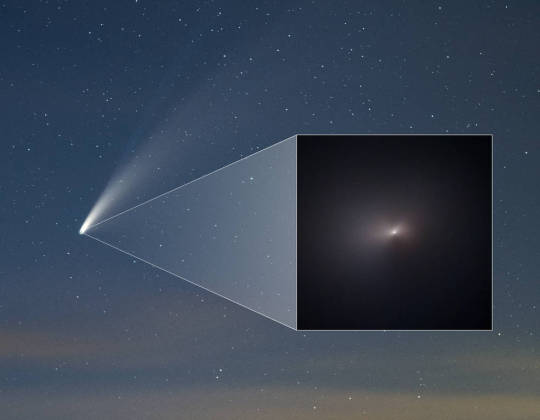
View On WordPress
0 notes
Link
NEOWISE is depicted in an artist’s concept in front of an image of the infrared sky captured by the mission showing asteroid Holda (the string of red dots moving across the sky). Holda was the first near-Earth object the mission detected shortly after the space telescope was reactivated in 2013.NASA/JPL-Caltech The asteroid and comet-hunting infrared space telescope has gathered an impressive haul of observations, but it’s now at the mercy of the Sun, which is accelerating its demise. NASA’s NEOWISE has had a busy decade. Since its reactivated mission began on Dec. 13, 2013, the space telescope has discovered a once-in-a-lifetime comet, observed more than 3,000 near-Earth objects, bolstered international planetary defense strategies, and supported another NASA mission’s rendezvous with a distant asteroid. And that’s just a partial list of accomplishments. But all good things must come to an end: Solar activity is causing NEOWISE – short for Near-Earth Object Wide-field Infrared Survey Explorer – to fall out of orbit. By early 2025, the spacecraft is expected to drop low enough into Earth’s atmosphere that it will become unusable. Eventually, it will reenter our atmosphere, entirely burning up. About every 11 years, the Sun experiences a cycle of increased activity that peaks during a period called solar maximum. Explosive events, such as solar flares and coronal mass ejections, become more frequent and heat up our planet’s atmosphere, causing it to expand. Atmospheric gases increase drag on satellites orbiting Earth, slowing them down. With the Sun currently approaching its next maximum, NEOWISE will no longer be able to maintain its orbit above our atmosphere. Comet C/2020 F3 NEOWISE appears as a trio of fuzzy red dots in this composite of several infrared images captured by the NEOWISE mission on March 27, 2020. These observations helped astronomers determine the comet’s path shortly after its discovery.NASA/JPL-Caltech “The mission has planned for this day a long time. After several years of calm, the Sun is waking back up,” said Joseph Masiero, NEOWISE’s deputy principal investigator and a scientist at IPAC, a research organization at Caltech in Pasadena, California. “We are at the mercy of solar activity, and with no means to keep us in orbit, NEOWISE is now slowly spiraling back to Earth.” WISE Beginnings The past 10 years represent a second life for the spacecraft. Managed by NASA’s Jet Propulsion Laboratory in Southern California, NEOWISE repurposed a different mission that launched in 2009: the Wide-field Infrared Survey Explorer (WISE). Data from WISE and NEOWISE has been used to study distant galaxies, cool stars, exploding white dwarf stars, outgassing comets, near-Earth asteroids, and more. In 2010, WISE achieved its scientific goal of conducting an all-sky infrared survey with far greater sensitivity than previous surveys. The WISE mission also found tens of millions of actively feeding supermassive black holes across the sky. Through the Disk Detective project, citizen scientists have used WISE data to find circumstellar disks, which are spinning clouds of gas, dust, and rubble around stars. Invisible to the naked eye, infrared wavelengths are emitted by warm objects. To keep the heat generated by WISE itself from interfering with its observations of infrared wavelengths, the spacecraft relied on cryogenic coolant. After the coolant ran out and WISE had mapped the sky twice, NASA put the spacecraft into hibernation in February 2011. Explore NASA's interactive Eyes on Asteroids Without coolant, the space telescope could no longer observe the universe’s coldest objects, but it could still see near-Earth asteroids and comets, which are heated by the Sun. So NASA reactivated the spacecraft in 2013 with a more specialized role in mind: aiding planetary defense efforts by surveying and studying those objects, which can stray into our planet’s orbital neighborhood and create a potential impact hazard. Astronomers could not only rely on the mission to seek out these objects, but also use its data to figure out their size and albedo – how much sunlight their surfaces reflect – and to gather clues about the minerals and rocks they’re composed of. “NEOWISE has showcased the importance of having an infrared space survey telescope as part of NASA’s planetary defense strategy while also keeping tabs on other objects in the solar system and beyond,” said Amy Mainzer, the mission’s principal investigator at the University of Arizona in Tucson. Mainzer is also leading NASA’s upcoming NEO Surveyor, which will build on NEOWISE’s legacy. The next-generation infrared space telescope will seek out some of the hardest-to-find near-Earth objects, such as dark asteroids and comets that don’t reflect much visible light, as well as objects that approach Earth from the direction of the Sun. Scheduled for launch in 2027, the JPL-managed mission will also search for objects known as Earth Trojans – asteroids that lead or trail our planet’s orbit – the first of which WISE discovered in 2011. Comet NEOWISE and Beyond Since becoming NEOWISE, the mission has scanned the entire sky over 20 times and made 1.45 million infrared measurements of over 44,000 solar system objects. That includes more than 3,000 near-Earth objects, 215 of which NEOWISE discovered. Data from the mission has contributed to refining the orbits of these objects while gauging their size as well. Its forte is characterizing near-Earth asteroids. In 2021, NEOWISE became a key component of an international planetary defense exercise that focused on the hazardous asteroid Apophis. The mission has also discovered 25 comets, including the long-period comet C/2020 F3 (NEOWISE). The comet became a dazzling celestial object visible in the Northern Hemisphere for several weeks in 2020 and the first comet that could be seen by the naked eye since 2007, when Comet McNaught was primarily visible in the Southern Hemisphere. Future researchers will continue to rely on the vast archive of NEOWISE observations to make new discoveries, similar to the way researchers used WISE data from 2010 long after the observations were made to characterize asteroid Dinkinesh in support of NASA’s Lucy mission before its October 2023 encounter. “This is a bittersweet moment. It’s sad to see this trailblazing mission come to an end, but we know there’s more treasure hiding in the survey data,” said Masiero. “NEOWISE has a vast archive, covering a very long period of time, that will inevitably advance the science of the infrared universe long after the spacecraft is gone.” More About the Mission NEOWISE and NEO Surveyor support the objectives of NASA’s Planetary Defense Coordination Office (PDCO) at NASA Headquarters in Washington. The NASA Authorization Act of 2005 directed NASA to discover and characterize at least 90% of the near-Earth objects more than 140 meters (460 feet) across that come within 30 million miles (48 million kilometers) of our planet’s orbit. Objects of this size can cause significant regional damage, or worse, should they impact the Earth. JPL manages and operates the NEOWISE mission for PDCO within the Science Mission Directorate. The Space Dynamics Laboratory in Logan, Utah, built the science instrument. Ball Aerospace & Technologies Corp. of Boulder, Colorado, built the spacecraft. Science data processing takes place at IPAC at Caltech. Caltech manages JPL for NASA. For more information about NEOWISE, visit: https://www.nasa.gov/neowise Share Details Last Updated Dec 13, 2023 Related TermsNEOWISECometsJet Propulsion LaboratoryNear-Earth Asteroid (NEA)NEO Surveyor (Near-Earth Object Surveyor Space Telescope)Planetary DefensePlanetary Defense Coordination OfficeWISE (Wide-field Infrared Survey Explorer) Explore More 6 min read NASA’s Perseverance Rover Deciphers Ancient History of Martian Lake Article 1 day ago 5 min read NASA Sensor Produces First Global Maps of Surface Minerals in Arid Regions Article 2 days ago 3 min read Students Create Elaborate Homemade Machines for JPL Competition Article 5 days ago
0 notes
Text
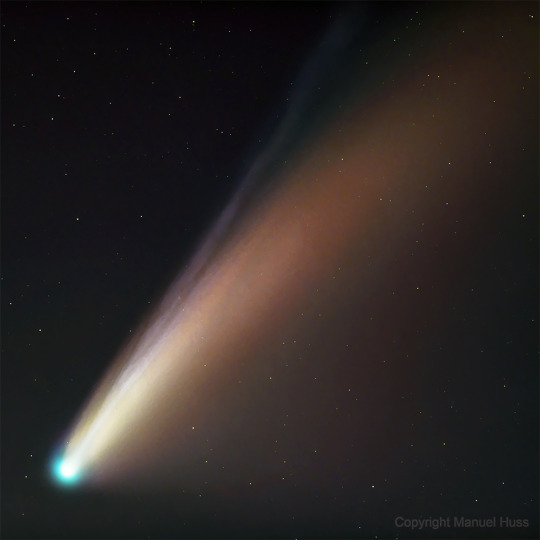
Comet Neowise with two tails l Manuel Huss
#comet#space#nasa#astrophotography#astronomy#comet neowise#universe#stars#night#galaxy#sky#planets#solar system#c/2020 f3
1K notes
·
View notes
Photo

Comet NEOWISE on July 19, 2020 // José María Moreno Santiago
#astronomy#astrophotography#solar system#oort cloud#comet#icy body#C/2020 F3 (NEOWISE)#Comet NEOWISE#NEOWISE
46 notes
·
View notes
Text
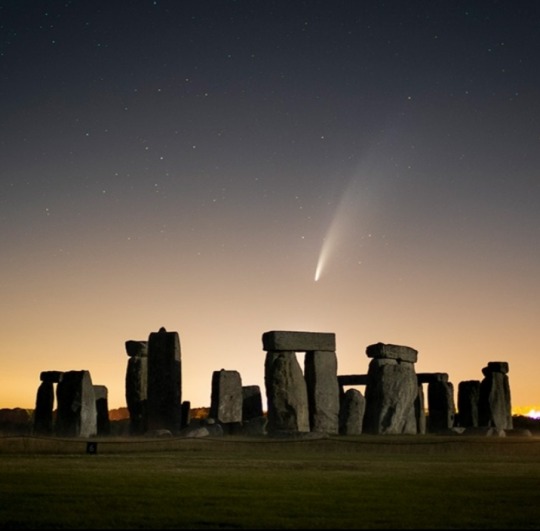
A once in a lifetime picture. ☄️
On Saturday, 11 July 2020, Comet NEOWISE was spotted over Stonehenge.
It's been the brightest comet of the 21st century making it visible to the naked eye despite being around 400 times further away than the moon.
📷: @Josh_Dury
NOTE:
C/2020 F3 (NEOWISE) or Comet NEOWISE is a long period comet with a near-parabolic orbit discovered on 27 March 2020 by astronomers during the NEOWISE mission of the Wide-field Infrared Survey Explorer (WISE) space telescope.
#Comet NEOWISE#Stonehenge#comet#Wide-field Infrared Survey Explorer (WISE)#NEOWISE mission#C/2020 F3
45 notes
·
View notes
Photo
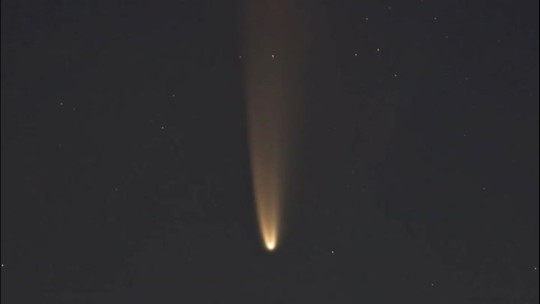
Astronomy #Space #Espace #Astrometry
0 notes
Text
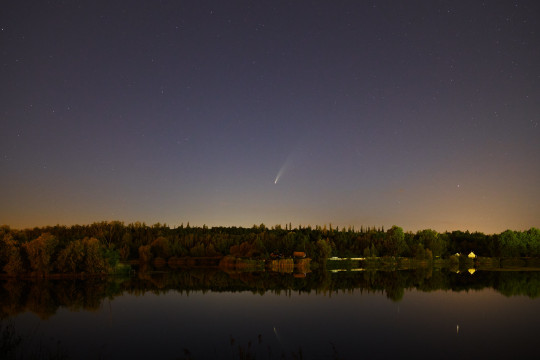

C/2020 F3 NEOWISE (2) by Andrzej Libiszewski
0 notes
Text
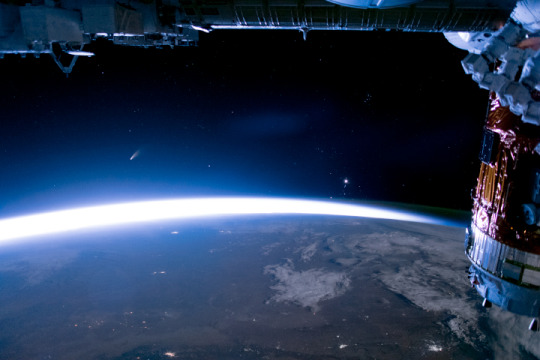
On This Day in 2020: Comet NEOWISE
Since NASA Earth Observatory started publishing images in 1999, the archive has grown to contain more than 17,000 stories. This week, Image of the Day stories highlight this robust archive with a look back at images acquired “on this day.” Our brief retrospective illustrates that Earth observations are more than just snapshots in time; together they allow us to better understand—and marvel at—our diverse, changing planet. This story was originally published with the text below on July 18, 2020.
Look up toward the stars this month, and you just might spot the brightest comet to grace Northern Hemisphere skies in decades. In July 2020, comet NEOWISE (short for C/2020 F3 NEOWISE) has thrilled skywatchers in North America, in Europe, and in space. If you don’t spot the comet this time around, you won’t get another chance. It has a long, elliptical orbit, so it will be approximately 6,800 years before NEOWISE returns to the inner parts of the solar system.
Comet Neowise has a nucleus measuring roughly 5 kilometers (3 miles) in diameter, and its dust and ion tails stretch hundreds of thousands to millions of kilometers while pointing away from the Sun. The icy visitor was discovered on March 27, 2020, by NASA’s Near-Earth Object Wide-field Infrared Survey Explorer (NEOWISE) spacecraft as the comet was headed toward the Sun. The comet made its closest approach to the Sun on July 3, and then turned back toward the outer solar system.
Comets are made of frozen leftovers from the formation of the solar system roughly 4.6 billion years ago. The masses of dust, rock, and ice heat up when approaching the Sun; as they get closer, they spew gases and dust into a glowing head and tail. Satellite data indicate the NEOWISE has a dust tail and possibly two ionized gas tails. The comet is made visible by sunlight reflecting off of its gas emissions and dust tail.
“It’s quite rare for a comet to be bright enough that we can see it with the naked eye or even just with binoculars,” said Emily Kramer, a co-investigator of the NEOWISE satellite, in a NASA Science Live webcast. “The last time we had a comet this bright was Hale-Bopp back in 1995-1996.
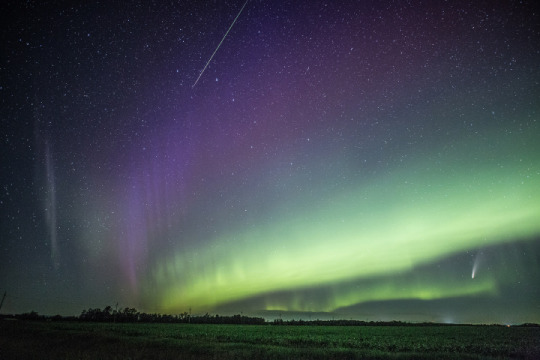
The photo above shows the comet (bottom-right) on July 14, 2020, against the backdrop of a green aurora in western Manitoba, Canada. The bright streak at the top is a meteor. The purple, ribbon-like structure is an aurora-like structure called STEVE (short for Strong Thermal Emission Velocity Enhancement), a phenomenon that was recently discovered with help from citizen scientists. Donna Lach, the photographer and an avid participant in the Aurorasaurus project, observed the scene for three hours and said the comet even out-shined the brilliant aurora at times.
Astronaut photograph ISS063-E-39888 was acquired on July 5, 2020, with a Nikon D5 digital camera using a focal length of 28 millimeters. It is provided by the ISS Crew Earth Observations Facility and the Earth Science and Remote Sensing Unit, Johnson Space Center. The image was taken by members of the Expedition 63 crew. The image has been cropped and enhanced to improve contrast, and lens artifacts have been removed. The International Space Station Program supports the laboratory as part of the ISS National Lab to help astronauts take pictures of Earth that will be of the greatest value to scientists and the public, and to make those images freely available on the Internet. Additional images taken by astronauts and cosmonauts can be viewed at the NASA/JSC Gateway to Astronaut Photography of Earth. Time-lapse animation by Sara Schmidt of the Earth Science and Remote Sensing group at NASA JSC. Aurora and comet photograph by Donna Lach, used with permission. Caption by Kasha Patel.
0 notes